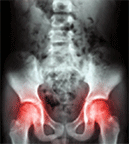
When working in a clinic that sees orthopedic conditions of children, it’s
important to be able to work through differential diagnoses of pediatric hip
conditions and be able to rule them out from more routine strains, sprains, etc.
Ability to recognize differential Dx and know when to refer a patient on for
imaging or orthopedic consult can be critical to the patient’s treatment and
prognosis. Three distinct conditions that one would want to understand would be
Transient Synovitis, Slipped Capital Femoral Epiphysis, and Legg-Calve-Perthes’
Disease.
Transient Synovitis:
Transient Synovitis is the most common cause of acute hip pain in younger
children (3-10). Pain is caused by a transient inflammation of the synovial
membrane. Most commonly unilateral hip or groin pain is reported, however
patients may report medial thigh or knee pain as well. Recent history of an
upper respiratory infection, pharyngitis, bronchitis, or otitis media is seen in
around half of patient’s diagnoses with transient synovitis. Boys are affected
twice as often as girls. Common complaint is “just woke up and started hurting.”
Condition will typically resolve in 7-10 days. Blood work and presence of fever
are commonly used to differentially diagnose from septic arthritis of the hip,
which is a true medical emergency that requires prompt care. X-ray used to rule
out Slipped Capital Femoral Epiphysis and Legg-Calve-Perthes Disease.
Clinical presentation:
-Age 3-10, boys:girls 2:1
-Pain complaint is pain in hip joint
-Often antalgic gait due to pain
-Can have recent history of respiratory infection
-May have low grade fever
Slipped capital femoral epiphysis:
Slipped capital Femoral Epiphysis is a fracture of the growth plate of the
femoral head that resulting in a slip of the physis resulting in a malalignment
of the head of the femur compared to the rest of the femur. Cause is not known,
but can be linked to falls/trauma. It is commonly seen right after periods of
fast growth such as near puberty. Most common in males (2-3:1), ages 10-17. The
condition is also much more common in obese individuals. Patients will present
with pain in the thigh, as well as the knee (often primary pain complaint),
typically eliciting an antalgic limp. Decreased hip range of motions are common,
particularly being limited into internal rotation due to the now off shape of
the joint complex. This condition requires surgical intervention and has a 20%
probability of occurrence in contralateral hip within 18 months. If suspected,
make patient NWB and refer for further work up!
Clinical Presentation:
-Age 10-17
-Males:females, 2-3:1
-More common in obese individuals
-Waddling gait
-Hip range of motion loss, especially internal rotation
-Shortening of limb
-Externally rotated limb
-Often vague pain in anterior supra-patellar knee
-Adductor spasm
Legg-Calve-Perthes’ Disease:
LCPD is an avascular necrosis of the proximal femoral head due to decreased
blood supply in the area. The disease comes on insidiously and may have link
after injury to hip. Most commonly it is seen unilaterally (Bilateral
presentation is less than 10% of cases) and in children aged 4-10. When the
disease is diagnosed prior to age 6, prognosis is good. It is much more common
in males (4-5:1) and rare in African Americans. An increased incidence is noted
with family history.
Clinical presentation:
- age 4-10
-Male:Female, 4-5:1
-Antalgic gait
-Limited internal rotation when in both flexed and extended positions, decreased
abduction
-Trendelenburg gait
-Weak and painful hip musculature
Hopefully these descriptions and presentation bullet points will aid clinicians
in knowing when to refer on for optimal patient care!
Last revised: 6, 17 2016
by Bill Lyon, PT, DPT, OCS, CSCS, USAW-L1
References
1)
http://www.wheelessonline.com/ortho/legg_calve_perthes_disease
2)
http://www.wheelessonline.com/ortho/slipped_capital_femoral_epiphysis
3) Placzek, J., Boyce, D. 2006. Orthopaedic Physical Therapy
SECRETS. Second Edition. St. Louis, MO: Mosby Elsevier







